Elnath, also known as Beta Tauri, is the second-brightest star in the zodiacal constellation of Taurus. It is the 27th brightest star in the night sky and it is a mercury-manganese star – a type of non-magnetic chemically peculiar star.
Key Facts & Summary
- Elnath is a blue-white giant star of spectral type B7 III, located at around 134 light-years / 41.1 parsecs away from Earth.
- It is a B-class giant star that has evolved away from the main sequence to become a giant star, larger and cooler than when it was on the main sequence.
- It has also been classified as a mercury-manganese star – a type of non-magnetic chemically peculiar star with unusually large signatures of heavy elements in its spectrum.
- Elnath has an apparent magnitude of 1.65 and an absolute magnitude of – 1.42.
- Elnath is around 5 times more massive than our sun and has around 4.2 solar radii.
- Elnath is 700 times brighter than our sun and has a rotational velocity of around 59 kilometers / 36.6 miles per second, much faster than our sun.
- Estimates suggest that Elnath has surface temperatures of around 13.824 K.
- The blue giant may have some visual companions but there is a faint star close enough to Elnath that might by gravitationally bound to it.
- This companion has been designated as a BD+28 795B and it is separated from Elnath by around 33.4 arcseconds.
- Because Elnath is situated on the border between the constellations of Taurus and Auriga, it was once known as Gamma Aurigae.
- It is believed that Elnath will evolve into a larger but cooler orange giant star.
- Elnath’s age has been estimated to be around 100 million years, much younger than our sun.
- Since Elnath has some prominent lines of silicon and chromium, it was also classified by some researchers as a SrCrEu star or an Ap star.
Long ago, around the 2nd century, Ptolemy considered Elnath to be shared between the constellations of Taurus and Auriga. His vision was shared for hundreds of years even by the German astronomer Johann Bayer who assigned Elnath two designations – Beta Tauri and Gamma Aurigae. The Gamma Aurigae designation stopped being used in 1930 when the constellation boundaries were better defined.
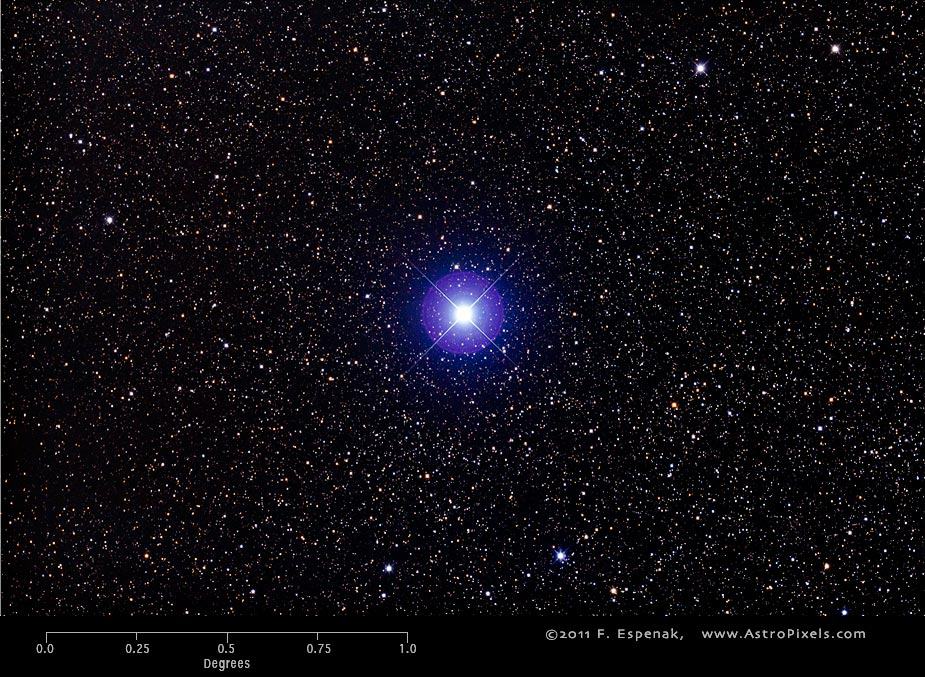
The name Elnath originates from the Arabic language and roughly translates to “the butting” or the “bulls horns”. Different spellings existed for Elnath, such as El Nath or Alnath. The name was once used for the star Hamal, the brightest star in the zodiacal constellation of Aries. The name was finally established and approved in 2016 by the International Astronomical Union’s Working Group on Star names.
Formation
Elnath is believed to have been formed around 100 million years ago. It is a star much younger than our sun. Elnath formed after gravity pulled together swirling gas and dust together.
Its peculiar heavy elemental composition can only be traced back from other stars that have exploded and blasted their heavier elements into space.
Distance, Size, and Mass
Elnath is located at around 134 light-years / 41.1 parsecs away from Earth. It has evolved away from the main sequence to become a giant star, larger and cooler than when it was on the main sequence.
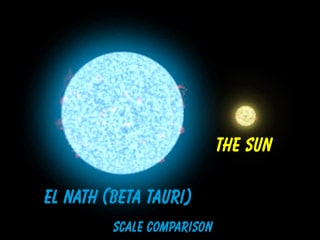
Currently, Elnath is estimated to have around 5 solar masses, and around 4.2 times the sun’s radius. Usually, the diameter of a star is double its radius thus Elnath’s diameter might be around 9 times greater than the sun’s.
Other Characteristics
Elnath is a blue-white giant star of spectral type B7 III, with an apparent magnitude of 1.65 and an absolute magnitude of – 1.42. It is 700 times brighter than our sun and has a rotational velocity of around 59 kilometers / 36.6 miles per second, much faster than our sun. Estimates suggest that Elnath has surface temperatures of around 13.824 K, or around 2.3 times hotter than the sun.
Elnath is a mercury-manganese star, having prominent lines of heavy elements in its spectrum. It has a higher abundance of manganese than our sun, yet it doesn’t have a high mercury signature. Because of this and due to the star’s prominent lines of silicon and chromium, some scientists classified the star as a SrCrEu star or an Ap star.
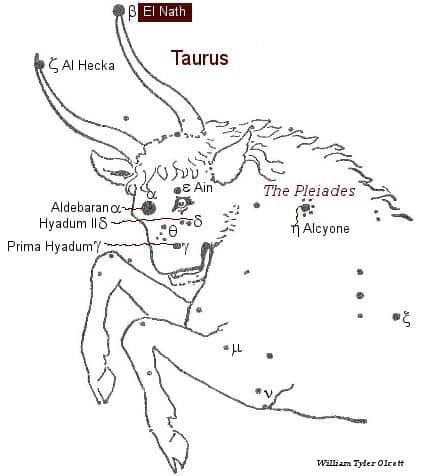
Elnath has around six visual companions but they aren’t physically related to it. A faint star that is close enough to Elnath might by gravitationally bound to it and thus Elnath may be considered a binary star.
This companion has been designated as a BD+28 795B and it is separated from Elnath by around 33.4 arcseconds. Further observations strive to prove the companion star’s association with Elnath.
Location
Elnath is located in the zodiacal constellation of Taurus – the celestial Bull. This ancient constellation has many bright stars and interesting deep-sky objects such as Aldebaran, and the bright open clusters Pleiades and Hyades.
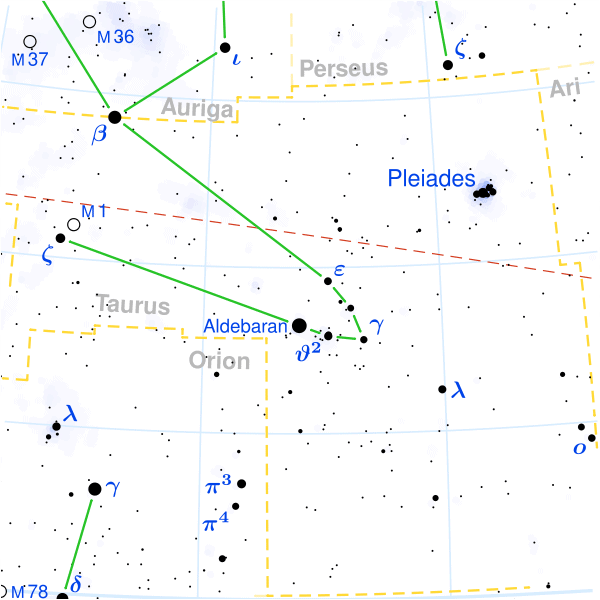
Elnath forms a prominent hexagon pattern with some of the brightest stars in the constellation of Auriga. The star is located at the constellations borders, being the nearest bright star to the galactic anticentre, which lies at the opposite end of the sky to Saggitarius A – the supermassive black hole located at the center of the Milky Way.
Many stars and deep-sky objects in the constellation of Taurus are best seen during the month of January, but when it comes to Elnath, it is visible throughout the year with the exception of June, when the star is very close to the sun.
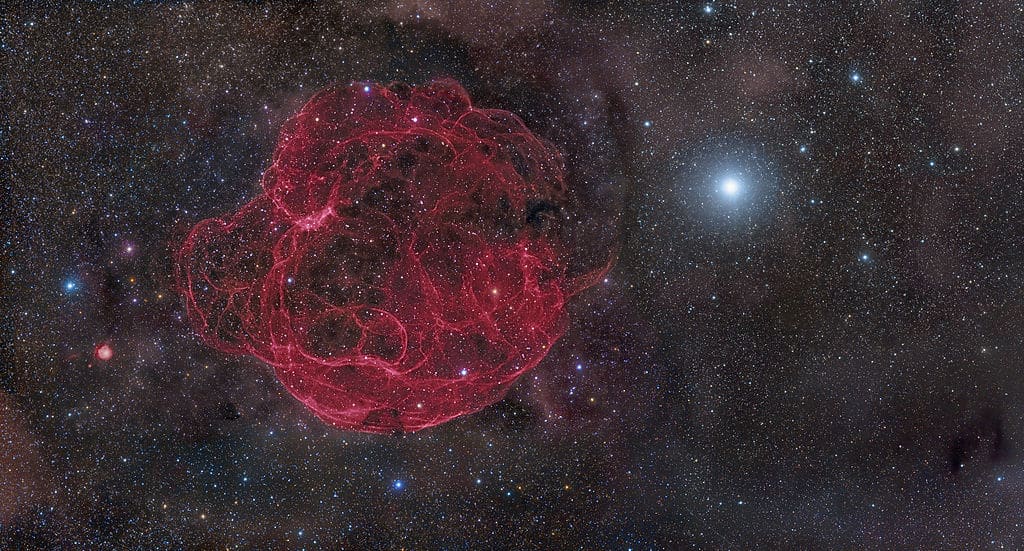
The Future
Elnath is quite a young star and it will continue to evolve into an even larger star, though much more cooler, in another couple of million years.
Did you know?
- Elnath and its close neighbor Aldebaran, are among the 58 stars selected for celestial navigation. Only stars that are bright enough, and easily recognizable are part of this group.
- Another Arabic variation of the name Elnath translates to “the heel of the rein-holder” – referring to Elnath’s position in the constellation of Auriga. Other older Arabic variants translate as “the Northern Horn of the Bull.”
- Another variant similar to the one above comes from the Babylonian language. Elnath was known as the “star in the Bull toward the north” or the “north star toward the chariot” – referring to the constellation of Auriga – the celestial charioteer.
- The Chinese knew Elnath as the Fifth of the Five Chariots – an asterism formed by many stars from the Auriga constellation.
- A star similar in properties to Elnath is Maia. Maia is one of the brightest stars in the Pleiades cluster, though larger and brighter than Elnath.
- In the Star Trek series, of the main characters – Spock – is pulled off course during a mission and must land on Taurus II – a planet which orbits Elnath/Beta Tauri.
Sources:
Image source:
- http://astropixels.com/stars/images/Elnath-01w.jpg
- https://en.es-static.us/upl/2011/01/elnath.jpeg
- https://www.constellationsofwords.com/images/stars/ElNath.JPG
- https://upload.wikimedia.org/wikipedia/commons/thumb/3/31/Taurus_constellation_map.svg/600px-Taurus_constellation_map.svg.png
- https://www.star-facts.com/wp-content/uploads/2019/11/Elnath-and-Simeis-147.jpg?189db0&189db0
